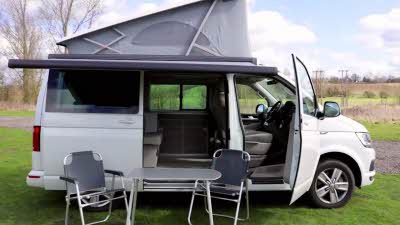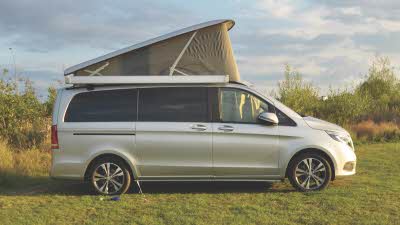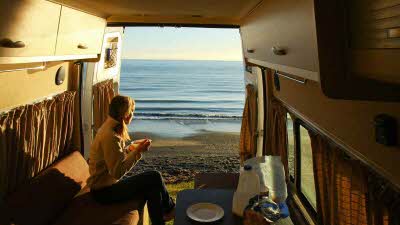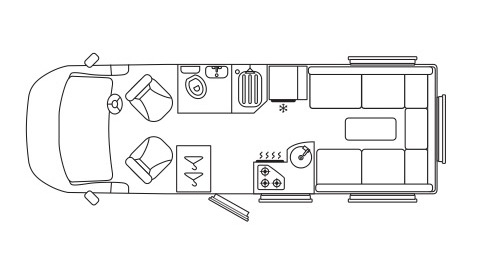Auto Campers Leisure Van
The Auto Campers Leisure Van offers plenty of flexibility with two or four berth options and coming on either a Ford Transit or VW Transporter base. It works well as both a family campervan or for daily driving, as George Hinton found out.
We tested a sister model to this Auto Campers Leisure Van (LV) in 2016. Based on a Euro 5 Ford Transit Custom, we had one or two reservations about its driveability. The model on review here features an uprated Euro 6 engine and an automatic gearbox option.
Build quality – 91%
The standard base vehicle features Ford’s Trend spec but our demonstrator was in £2,000 optional Limited trim, which adds cab air conditioning, 16in alloy wheels and colour-coded side rubbing strakes, rear bumper, handles and mirrors. Engines offered are the 128bhp or 168bhp diesels.
For Volkswagen devotees, the LV (elevating-roof version only) can be based on the Transporter, if preferred. Costing £8,500 more, it opens the possibility of adding four-wheel-drive, useful if you prefer basic CLs etc.
The Ford version is available as a Lo-line, Hi-line or pop-top. We’re testing the latter, featuring a Reimo rear-hinged elevating roof, which opens up the option of an extra bed.
Ford’s Transit Custom can be specified in eight paint colours including red, blue, silver, black and magnetic grey (as here). The body is fully insulated.
The offside furniture unit houses a metre-long kitchen and full-height storage. The rear seat/bed is a British Titan rock-and-roll design with twin integral seat belts. A wide choice of options enables you to tailor your van precisely to your requirements.
Driving – 91%
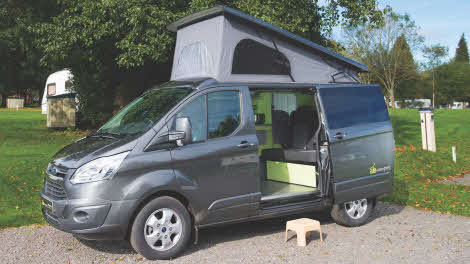
The car-like cab with Limited pack features cruise control, Ford SYNC with Bluetooth, auto lights, auto wipers, parking sensors both ends and a DAB radio/CD player. A reversing camera is optional.
The top-output engine produces 168bhp from just two litres, while Ford’s six-speed automatic comes with switchable stop-start to minimise emissions. Gear changes are slightly delayed when the vehicle is stone cold, but soon become smooth and well-timed.
This set-up has solved all the driveability issues we had with the Euro 5 manual version. Even economy, measured over 213 miles of mixed driving on fast and slow roads, was better at 30.7mpg. Ride quality is firm, but also very compliant when traversing drain gratings or potholes. There were no issues with steering (which is adjustable for rake and reach) or brakes, both of which were excellent. Seats are fully adjustable with lumbar support.
Daytime –76%
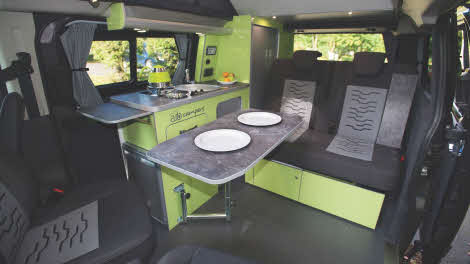
Once you’ve parked up, the first thing you need to do is disable the internal alarm sensors (the dash prompts you) using the buttons on the steering wheel. Then release the retaining straps and push the Reimo roof up, followed by the gas-strutted optional roof bed.
Storage being limited in a pop-top, the wardrobe has two shelves that can be folded away if you prefer the 32in-drop hanging space. The control unit/monitor for the 100W solar roof panel sits at the top, the 115Ah leisure battery living under a false floor in the base, with the cranked table leg stowed loose above it. The generously-sized table top clips to a rail inside the nearside sliding door, while both cab seats swivel for dining.
The rear tailgate gives access to storage sufficient for the cab window night screens, levelling ramps, mains cable etc, with the steel gas locker at the bottom for a large (907) Campingaz cylinder. Behind the seat is a large storage area with the option of travelling with the bed extension horizontal or vertical as required.
The LV, like the MRV, makes full use of the Custom’s twin sliding side doors. The kitchen is externally accessible from the offside, including fridge, cooker and cutlery drawer, so it’s the best side to fit the optional cassette awning for summer outdoor living. You can have a multi-rail fitted nearside, enabling use of a drive-away awning and even an outside shower.
There’s a 40-litre under-floor water tank, filled from the driver’s step well, but no water heater. The identical waste tank has a drain tap on its end plate. Optional space heating is by diesel-fired Webasto under the passenger seat and there’s
a full-size steel spare wheel to keep you mobile.
Night-time – 77%
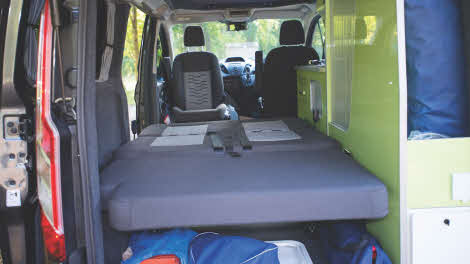
Bed make-up is wonderfully easy; lift the locking bar under the front edge of the seat and pull it towards you, the backrest dropping to horizontal as you go.
If you have travelled with the rear bed extension upright, you will need to go to the back of the van to release its ratchet and lower it. The seat belts remain in place – just tuck the buckles down between the cushions. Stowing the bed is equally easy: pull the strap at the hinge point while pushing the front edge back with your leg.
The 6ft 2in by 3ft 10in bed leaves sufficient space at the cab end to undress and use the portable toilet. The cushions are firm for sleeping, so we employed our faithful air mattresses for extra comfort, powering a 12V air pump from the adjacent 12V socket.
The stretchy blackout curtains were effective, although there were small gaps where they met. The roof bed is 6ft 6in by 3ft 11in – you can specify a ladder if clambering up using the cab seats and kitchen unit is not your bag. There are the usual features of a plastic front window and mesh side screens, with zipped canvas covers.
Kitchen – 69%
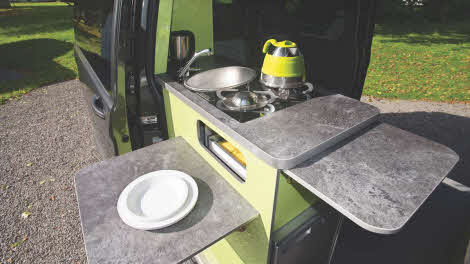
The kitchen is a simple set-up, with a two-burner, self-igniting CAN hob inset into a flush black glass surround.
Work area is augmented by two folding surfaces, one at the fridge, a second ‘outside’. The Dometic drawer-type, 50-litre electric fridge-freezer faces forwards, allowing access from inside or out. There’s a generous cutlery drawer, then an oval 14in sink in polished stainless steel. Two lower cupboards, closed by silver plastic tambour doors, accommodate food, pots and pans etc.
Lighting – 92%
Lighting is excellent – there are six LED downlights in the bottom of the upper bed base, while a further two near the tailgate provide illumination for reading or assist when loading the storage area. Two LED spotlights on stalks at the front serve both the roof bed and the lower area as required.
The solar panel and leisure battery provide independence (we did not hook-up over a long weekend), while paired 12V and 230V sockets allow use of a variety of accessories.
Verdict – 83%
For conventional camping, the user-friendly LV is a winner. It’s compact, good to drive and even highly capable as a towing vehicle – what’s not to like?


